Henry Kisor
When Chicago Sun-Times book editor Henry Kisor turned 53, he decided to learn how to fly and take a solo airplane trip across America. He faced the typical challenges of learning at middle age, plus one extra hurdle: He has been completely deaf since age three. Henry got his license, bought an airplane, planned and flew the trip, and wrote a book about it. In this month’s Profile, Henry recalls preparing for and flying his cross-country VFR adventure patterned after the 1911 flight of Cal Rodgers’s Vin Fiz.
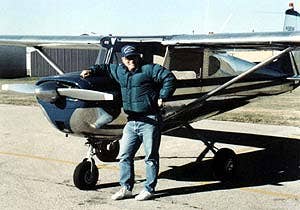
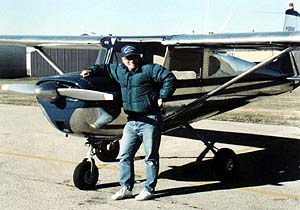 Henry Kisor was born August 17, 1940, inRidgewood, N.J. Age three brought his first experience in the cockpit of a TBF Avenger,and a bout with meningitis that would take away his ability to hear. Henry's parentstaught him to read and to read lips and to find his place in a hearing world. He earned aB.A. from Trinity College in Hartford, Conn., and an M.S.J. from Northwestern Universityin 1964. He began his newspaper career in 1964 with the Evening Journal in Wilmington,Del., and has been the book revieweditor and literary critic of the Chicago Sun-Times since 1978, after five years inthe same position with the old Chicago Daily News. Between 1977 and 1982 he was an adjunctinstructor at Northwestern University's Medill School of Journalism. From 1983 to 1986 hewrote a weekly syndicated column on personal computers that appeared in the ChicagoSun-Times, Los Angeles Herald-Examiner, Orlando Sentinel, Seattle Times and othernewspapers.
Henry Kisor was born August 17, 1940, inRidgewood, N.J. Age three brought his first experience in the cockpit of a TBF Avenger,and a bout with meningitis that would take away his ability to hear. Henry's parentstaught him to read and to read lips and to find his place in a hearing world. He earned aB.A. from Trinity College in Hartford, Conn., and an M.S.J. from Northwestern Universityin 1964. He began his newspaper career in 1964 with the Evening Journal in Wilmington,Del., and has been the book revieweditor and literary critic of the Chicago Sun-Times since 1978, after five years inthe same position with the old Chicago Daily News. Between 1977 and 1982 he was an adjunctinstructor at Northwestern University's Medill School of Journalism. From 1983 to 1986 hewrote a weekly syndicated column on personal computers that appeared in the ChicagoSun-Times, Los Angeles Herald-Examiner, Orlando Sentinel, Seattle Times and othernewspapers.
Henry has won many prizes and citations for his work, and was named a finalist for thePulitzer Prize for Criticism in 1981. The Friends of Literature awarded him the firstJames Friend Memorial Critic Award in 1988 and the Chicago Foundation for Literature Awardfor Nonfiction in 1991 for What's That Pig Outdoors?- A Memoir of Deafness.
Flight of the Gin Fizz: Midlife at 4,500 Feet is Henry's 1997 account of hisre-enactment of a flight by Cal Rodgers's in 1911. Cal flew a Wright Model EXcalled the "Vin Fiz" which now hangs in the National Air and Space Museum.Henry flew the trip in a polished-aluminum 1959 Cessna 150 he named "Gin Fizz".He flew over a period of five weeks in three separate sorties to minimize time away fromhome and work. It would be an ambitious trip for anyone, especially so for a low-time VFRpilot who can't hear. Flight is the kind of well-crafted book you might expect fromsomeone who has been reviewing them for 30 years. Henry has the knack for includingexplanations of the concepts of aviation to a non-pilot audience without losing theaudience of pilots.
Author's note: This is the first AVweb Profile interview that hasn't been conducted orally in one sitting and then transcribed. As an editor, Henry often interviews authors via email, so we used a series of emails over a recent weekend to capture his thoughts. -JG
What's your earliest memory of wanting to fly?
I think the seed was planted in 1943 when I was three years old. My dad was a supplyofficer at the old Fort Lauderdale Naval Air Station, which trained torpedo bomber pilots.I remember sitting in the pilot seat of a Grumman TBF and waggling the joystick, and itwas probably at that time the impulse to fly overtook me, though I was of course too youngto know what it meant. By age five, I could tell a Me. 109 from a Spitfire, thanks to theaircraft recognition charts tacked to my bedroom wall. "Terry and the Pirates"and "Steve Canyon" naturally were my favorite comic strips.
By 1951 the hook was well and truly set. My dad, who had built free-flight modelairplanes and competed in contests all through the war years, introduced me to U-controlmodel planes as soon as I was old enough to handle one. I recalled just recently thatsomeone remarked that I never seemed to get dizzy spinning around and around with theairplane, as many of my friends did. That was because my balance organs had been destroyedby the meningitis that took my hearing. That summer of '51 Dad took me to the local grassairfield at Hallstead, Pa., where the proprietor's son, who had flown in combat during thewar, was the proud owner of a Globe Swift 125. For five dollars he took me up for 15minutes, and we did barrel rolls. I was 11 years old, and I have never forgotten theexhilaration of that ride.
Did not being able to hear deter you from pursuing that exhilaration?
It did at first, owing to my own ignorance. While still a child, I bought the"common sense" that deaf people could not fly because they couldn't use theradio. It wasn't until I was well into adulthood that I met a deaf pilot - anorthodontist from California who owned a Tri-Pacer - and discovered that wasn't true atall; that radio communications were not required in uncontrolled airspace and that therehad been deaf pilots since almost the beginning of aviation. Later, a greater deterrentwas having to raise a family and send two kids to college. Not until after their schoolingwas paid for did I have enough money to learn to fly.
If your balance organs are destroyed do you still perceive positive and negative Gforces?
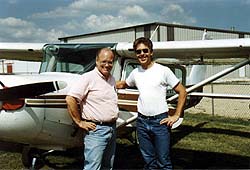 Henry and CFI Tom Horton |
Of course. I can feel the pull of gravitation throughout my whole body in a turn or asharp dive or climb. The most important consequence of losing the balance organs is, ofcourse, losing one's inner sense of balance. In practical terms this means I can't keep mybalance with my eyes closed, or when it's completely dark. At home I need a night light,else I'd fall flat on my face heading for the bathroom. In the cockpit I need a visualhorizon - or an attitude indicator. I suspect that people who have lost their balanceorgans don't suffer from the misleading "seat of the pants" feeling that up isdown and down is up - we simply have no idea where up is until we can see it. Perhapsthat makes it easier for us to recover from "unusual attitudes." I've nevertested this theory, however.
What was the process of picking a CFI for your training?
A private pilot named Bob Locher, who got me off the dime at last when he gave me aride in his 172 during the fall of 1992, urged me from the get-go to train with his oldinstructor, a corporate Citation pilot named Tom Horton, who instructs out of WestoshaAirport (then WI10; now 5K6) at Wilmot, Wis., about an hour and five minutes north of myhouse in Evanston, Ill. Horton, he said, had trained a deaf student to the privatecertificate some time before, so we wouldn't need to reinvent the wheel. At first I didn'tcotton to the idea of driving all that way once or twice a week, so called the localoffice of a famous national flight school at Palwaukee Airport (PWK) in Wheeling, Ill.,using the deaf phone relay service and my TDD (Telephone Device for the Deaf, a kind oflaptop).
The factotum who answered said sorry, there were no openings. I asked whether theremight be an opening for a student six months later. She said oh no, they were full then,too. Yeah, sure. Briefly I considered siccing the Justice Department on the schoolcourtesy of the Americans with Disabilities Act, which prohibits such discrimination. Butthat game did not seem worth the candle, partly because a lawsuit wouldn't smooth the wayto the mutual trust I thought a student and instructor ought to share.
So I called the FBO at Galt Airport (10C) near McHenry, Ill., about 45 minutes away."Sorry, we're not set up to train the handicapped," the chief instructor said. Isuggested we try an introductory flight and see what the possibilities might be, whetherwe thought we could communicate well enough, before giving up on the idea. He thought thatwas reasonable and said okay. But before we could take the flight, I suffered an attack ofgood sense. Westosha and Tom Horton weren't much farther away than Galt, and it therewould be no need to go through that awkward and sometimes time-consuming negotiation ofproving to him that deaf people are perfectly capable human beings. I took an introductoryflight with Tom, and at the end of it said, "Hey, I can do this." He shruggedand said, "Why not?"
That was one of the smartest moves I ever made. Tom didn't need to instruct - he's afull-time corporate jet pilot, and teaches on weekends and his days off not just for extramoney but because he loves to teach. He wasn't one of those bored time-builders I kepthearing about who took no interest in their students as people. But he also had - and has- a reputation as a tough taskmaster. I knew he wasn't going to cut me any slack but holdme to the same standards he held his other students. After that first lesson, I knew I wasin good hands.
In retrospect, it probably was a good thing that the Palwaukee school turned me away.Palwaukee is a very busy Class Delta airport, and I'd have had trouble making solotakeoffs and landings there. An instructor would have had to fly with me to anuncontrolled airport for me to do solos, and that would have been hard to arrange.
How did Tom critique your performance during the lessons?
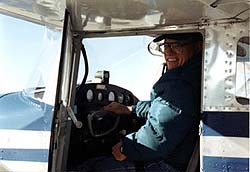 In the usual way, for the most part. If he had just a sentence ortwo to say, I'd glance over at him to read his lips. (He's very easy to understand.) If hehad more to say, he'd take the yoke and speak while scanning the sky so that I coulddevote my undivided attention to him.
In the usual way, for the most part. If he had just a sentence ortwo to say, I'd glance over at him to read his lips. (He's very easy to understand.) If hehad more to say, he'd take the yoke and speak while scanning the sky so that I coulddevote my undivided attention to him.
Only in landing-pattern drills did we have to do things in a different way. Theworkload in the pattern made me just too busy to look over at Tom, even briefly. Afterevery landing we'd pull off onto a taxiway while Tom explained what I'd done wrong and howto correct it. This technique was time-consuming, but there was no other solution. It didfurther my confidence in Tom - clearly he was making certain I understood everything.
There was just one miscommunication in the whole enterprise - when one day, just as wewere about to touch down, Tom reached up and pointed down the runway. I thought he wastelling me to do a touch-and-go, but he was trying to tell me to keep my eye on the farend of the runway. Once we sorted that out it never happened again.
Things got a little shaky during hood work. Tom had to write instructions on a pad ofpaper and shove them under my nose. His handwriting is almost as bad as mine, and once ortwice I pushed up the hood and said, "What the hell are you trying to tell me?"But we coped.
Tom would often tell me in detail what the day's lesson would be before we took off.Knowing what was coming made things a lot easier for me. (Tom never told me in advancewhen he was going to snake the throttle back and say, "Engine failure! Nowwhat?")
Otherwise, I believe teaching me was like teaching any other middle-aged student whowasn't as quick to grasp concepts as he might have been in his 20s. I even received aliberal dose of what Tom's former students fondly call the "You're Going to KillYourself, But Not with Me in the Plane" lecture, after I pulled up the nose on finalinstead of adding power when I perceived us to be too low.
Looking back on our instruction, I can't think of anything Tom might have done better.He treated me like any other student pilot, expecting me to live up to the exactingstandards he set for them.
What was different about your private pilot exam?
Nothing much. The most unusual aspect was that because a medical flight test was partof the usual checkride, an FAA safety inspector, not a designated examiner, had to performthe checkride.
The medical part of the test consisted of two parts. First, the examiner had to satisfyhimself that I could discern a stall; deaf pilots can't hear the stall warning horn. Thatwas easy. The controls go mushy, the aircraft judders and the airspeed indicator dropsbelow 40 knots. Second, I had to be able to discern the change in engine note when theexaminer snaked back the throttle for a simulated engine-out landing. That was just aseasy: Deaf people are very sensitive to vibration and a drop in RPM can be felt throughthe yoke as well as through the seat. (It's also easy to see that the propeller has sloweddown.) That took all of five minutes.
I had an exceptional safety inspector - Jimmy Szajkovics of the Milwaukee FSDO. Duringthe flight test, the wind picked up unexpectedly to about 20 knots with higher gusts, andduring one landing he had to take the yoke from me when a gust caused the airspeed tobleed off too much on final - and I froze uncertainly at the controls. I thought I'dblown the flight test right there, but Jimmy kept me going, and after that I managed tonail a couple of tough crosswind landings. Jimmy said he thought I was a good pilot andwould have the sense to stay home if the winds were beyond my competence, and so he signedme off.
How did you prepare for your first visit to a towered airport?
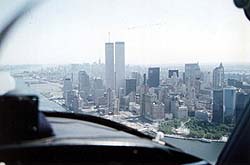 Gin Fizz and Manhattan with water on the side |
With a TDD, I phoned the tower - JVL, Janesville, Wis. - and asked clearance to enterthe Class Delta airspace for a light signal landing. They gave me an ETA, an altitude andan approach course, and I announced my presence on the radio, as arranged, as I enteredthe airspace. I used what I call a "Locherometer" after its builder, Bob Locher,to avoid tramping on other people's transmissions. This is a little box - technically aradio level meter - with a bright LED that I plug into the headphone socket. When there'straffic on the frequency, the LED lights up. When it's dark, I can speak into the radio.
Those light signals aren't easy to see - I missed them the first time and had to getback into the pattern. The second time around, I saw them clearly.
What factors went into your selection of a Cessna 150 as the airplane for your trip?
1. Money. 2. Money. 3. Money. A common two-seater was much more affordable than afour-seater like a 172, and I wanted an all-metal airplane because I'd be keeping it outon a tiedown during a Wisconsin winter. The one I found, a 1959 model, had just beenrefurbished by the Westosha mechanics, who worked there part-time (the fellow who did theairframe was American Eagle's maintenance chief at O'Hare and the guy who overhauled theengine was American Airlines' foreign maintenance boss, also headquartered at O'Hare).They gave it a year's guarantee against defects - and they honored that guarantee whenone of the mufflers had to be rewelded.
Flying coast-to-coast is a pretty ambitious trip for a newly-minted VFR pilot. Howdid you plan to handle changes in weather and in-flight emergencies?
Any time MVFR or winds exceeding 15 knots were forecast, I was going to stay down andread a book. This was my plan. Of course, I did not stick to it. On the way out to NewJersey to start the trip, I foolishly took off into absolute minimum conditions and had toland shortly afterward just a few miles from Westosha to wait out passing low clouds. Butthe God that watches out for fools and low-time pilots was with me the rest of the way -the weather was for the most part excellent. Only in hot and moist Texas was thevisibility lousy, and it still generally was comfortable enough.
Because I couldn't get weather updates in the air, I knew I was going to have to landfrequently and update myself on DUAT or the FBO's weather computer, if it had one. As itturned out, following the Cal Rodgers route across America, stopping everywhere he did,insured that I'd land almost every hour to look about me, talk with people, and get theweather.
That same God must have been watching out for Cal back in 1911, too. You startedwith a rather low opinion of him - Cal, not God - but it seemed like you gathered morerespect for what he had accomplished as you flew along his route.
Yes. At first Cal seemed like a wealthy know-it-all layabout who didn't listen to goodadvice and got himself in trouble because of his own stupidity. That he was courageous wasnever in doubt; from the beginning he kept going despite all those crashes he suffered.When the time limit for the Hearst prize ran out before he had made it halfway across thecountry but he decided to press on all the same - damn the bankers, full speed ahead -his innate tenacious character had become clear. When his engine blew out a cylinder justpast Imperial Junction, California, shooting splinters into his arm, he flew back severalmiles and made a smooth landing despite his injuries. That was coolness under fire. He hadbecome a true pilot.
You filled a book with the details of your adventure, but can you give us a glimpse ofthe more colorful characters you met in your journey?
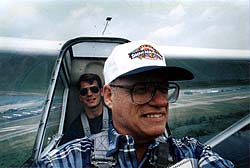 Henry and CFI Shane Lese seek thermals in a Schweizer 2-33 trainer |
Lordy, there are so many. Max Francisco, the one-eyed CFI in Hancock, N.Y. Shane Lese,the Elmira, N.Y., sailplane instructor and member of the Schweizer family. JosephineRichardson, the 80-year-old ex-Powder Puff Derby racer and dynamic owner of Decatur Hi-Wayairport in Indiana. Jim Shuttleworth, who rebuilt Gen. Robin Olds' Mustang and keeps it atHuntington, Ind. Airshow pilot Gene Littlefield and his wing-walker wife, Cheryl, at ClowAirport, Plainfield, Ill. Virgil (Rocky) Rothrock, a Stearman owner and proprietor of theairport at Streator, Ill., who keeps a genuine Santa Fe Railway caboose by the gas pumpsjust because it looks cool. Bob Searfoss, the old B-17 pilot at Mexico, Mo., whose prideand joy is a huge radio-controlled model of the Fortress he flew over Europe during WorldWar II - and whose parents saw Cal Rodgers fly over Missouri in 1911. Barbara MacLeod, theTexas anthropologist who beat a lifelong fear of flying and is now an aerobatic pilot. JimNewman, the double amputee who never let the loss of his legs keep him from flying. RayWilliams, the flying missionary who led me as a "flight of two" into the busycombined civil airport and Marine air station at Yuma, Arizona. All these and more showedme what diamonds of humanity were to be found scattered among the grassroots airports ofAmerica.
Who are your favorite authors?
Usually the last one whose book I've liked, but they run the gamut from pulp to lit -I'm a big fan of both Ed McBain's cop-shop mysteries and William Faulkner's heavy-dutynovels. Carl Hiaasen tickles my funnybone. Of the recent aviation books, I liked StacySchiff's biography of Saint-Exupery and Scott Berg's life of Charles A. Lindbergh. WilliamLangewiesche is a thoughtful aviation writer I like very much.
What's your opinion of the friction in the community of the deaf about lip readingand sign language?
It's so unnecessary. We're made up of diverse communities with diverse ways of dealingwith deafness, and they should all be honored. There's one group that does so cheerfully:the International Deaf Pilots Association. Our nextfly-in is at South County Airport at San Martin, Calif., from June 27 to July 1, 2000,and we invite anyone interested to attend.
Last fall Mark Stern, a deaf pilot (and friend ofmine) flew to all 48 lower states and posted a running commentary during the trip. Healso had a great many culinary adventures on the way - no vending-machine snacks for thisfellow. There's also a very good FAQ about deaf pilots on thesite.
What's your next challenge as a pilot? A new rating? Another trip and another book?
Just for the additional training, I might go for a commercial ticket, although withoutthe IFR rating it's about as useful as hind tit on a boar hog. Right now I'm concentratingon flying youngsters, deaf and hearing, in the EAA'sYoung Eagles program. Another aviation book hasn't yet suggested itself to me.
Flight of the Gin Fizz recently went out of print. Plenty of usedcopies as well as remainders can be found by going to Bibliofind.
Update July 2003:Henry has a new Web site and email address for AVweb readers to contact him.






